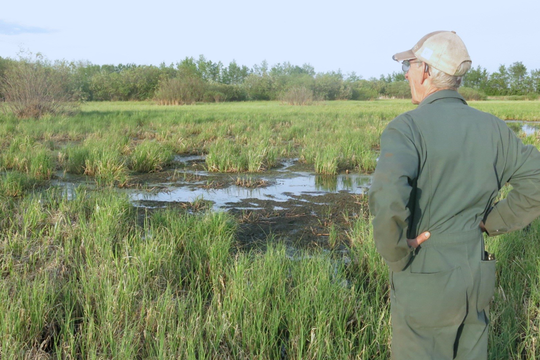Good Neighbours

What makes the Harrold Family Farm special?
For four generations, the Harrold family has operated their farm with the same philosophy that guides the Beaver Hills Biosphere, by “living and working in harmony with nature to inspire a positive future.”
Located near Lamont, Alberta, the Harrold Family Farm is situated on the northeast border of the Beaver Hills Biosphere. Although their farm is outside the Biosphere, the Harrolds share the Biosphere values of sustainability, history and stewardship.
"The whole ethos of our farming has always been one of conservation and preservation, right from my great-grandfather’s time forward," said Kirk Harrold.
Kirk and his wife Trudy have been part of Harrold Family Farm for 45 years. After meeting as university students, the pair moved back to the farm. Although she grew up in the city, Trudy quickly fell in love with life on the farm.
To illustrate the Harrold’s approach to life and business, Trudy created a farm mandala, representing the cyclical, interconnected nature of life on the farm. The mandala encompasses their philosophy and guides their work, allowing for flexibility as they respond to the needs of their environment and the changing seasons.
Circles are an essential metaphor for the Harrold’s way of life. Their mandala has three central circles: crops, livestock and stewardship. Surrounding the mandala’s main pillars are other significant influences on their farm: history, sustainability, family, nature and community.
So what does this mean on the farm? The Harrolds try to live in harmony with the local wildlife and the natural habitats the farm provides. Every living creature contributes to the farm community, from livestock grazing the pastures to coyotes controlling the rodent population to birds nesting in the farm’s aspen trees.
“When you consider it a community, there's a much greater tendency to take care of, participate in and understand it as opposed to simply looking at it as a means to an end,” said Kirk.
Stewardship, as one of the mandala’s central circles, isn’t merely a principle for approaching farming, it’s as integral to their farm as livestock and crops.
“The idea of stewardship is a lifestyle. It's not a formula. You can apply it to certain things, but really you live it,” said Kirk. “Stewardship is listening to the land and being aware of what it can do.”
Listening to the land can take different forms, from growing salt-tolerant grasses in saline-heavy riparian areas to selecting crops that grow best in the existing soil.
Their sustainability philosophy is to work with the land, not against it, responding to the farm's unique topography, waterways and soil composition. The existing environment informs what they plant and how they use the land. Nature informs development, not the other way around. It’s a philosophy closely aligned with the Man and the Biosphere programme.
“It’s important that we consider what environmental services are provided, rather than clearing trees, flattening and paving over the natural landscape. Economically and environmentally, it’s better to work with the land than against it,” said Kirk.
For example, the Harrolds grow hay in riparian areas, feeding livestock and providing ducks with habitat. Working with the land’s topography rather than “farming in the ditch” means the Harrolds don’t sink money into bending the land to their economic will. It’s a philosophy of cooperation with nature that ultimately makes the farm economically viable.
“It’s not a loss of land, just a different use of land,” said Kirk. “We try to balance the ecological and the economical when we make any decision.”
Ultimately, the mandala shows how everything is connected – not only plants and animals but the region's history and how it is developed sustainably for future generations. This wisdom is also at the heart of the Biosphere, where people live and work in harmony with nature.
In the same way the Biosphere is made up of interconnected parts working together, the Harrolds also see their cattle and crops as interdependent on the insects, birds and other animals that have always lived here. From Kirk’s perspective, a diversity of wildlife indicates the land is healthy, so preserving biodiversity is vital.
“All the birds and animals speak to us by their presence,” Kent Harrold, Kirk’s father, added. “I feel a kinship with them.”
In the same way Indigenous history and culture are critical to the Biosphere, Indigenous knowledge that teaches an interdependence on land is a philosophy Kirk and Trudy share. Respect for that history is essential to the Harrold family.
“We are the newcomers. We're the ones who really have limited knowledge about it,” said Kirk. “The Indigenous people who have used the Beaver Hills for generations have deep knowledge. What can we learn from that history?”
As like-minded neighbours of the Biosphere, the Harrolds have built and nurtured a sustainable community on their farm. The farm's natural landscape has brought their family joy for generations, and preserving that landscape for the future is at the forefront of their minds. From incorporating solar to preserving natural habitats for wild animals, the Harrolds are farming for the future.
Learn more about this extraordinary Biosphere neighbour, the Harrold Family Farm.